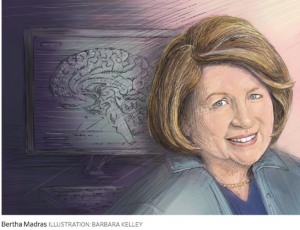
(Author’s note: The state of Florida has an amendment to the constitution on the ballot this Election Day that tries to legalize recreational marijuana. This amendment is being pushed by the marijuana commercial industry for obvious reasons, but is promoted by claiming it will reduce crime, increase school education funding, and make use of marijuana safer. To educate voters about the truth concerning marijuana usage, I am re-publishing a two-part blog from earlier this year.)
The Biden Administration wants to reclassify marijuana as a less dangerous Schedule III drug – on par with anabolic steroids and Tylenol with Codeine. The reason they want to do this is quite transparent – they want to buy the votes of young people in the next election. But is this good for these young people and the country?
In Part I , we learned about an interview of Bertha Madras, marijuana expert from Harvard Medical School, by Allysia Finley of The Wall Street Journal. She discussed her great concerns for this change since marijuana has significant side effects and causes more lasting damage to the brain than alcohol. Today we will read more about the dangers of marijuana usage:
Marijuana and Violence
Marijuana has also been associated with violent behavior, including in a study published this week in the International Journal of Drug Policy. Data from observational studies are inadequate to demonstrate causal relationships, but Ms. Madras says that the link between marijuana and schizophrenia fits all six criteria that scientists use to determine causality, including the strength of the association and its consistency.
Ms. Madras says at the beginning of the interview that she was operating on three hours of sleep after crashing on scientific projects. Yet she is impressively lucid and energized. She peppers her explanations with citations of studies and is generous in crediting other researchers’ work.
Marijuana and Pregnancy
Another cause for concern, she notes, is that more pregnant women are using pot, which has been linked to increased preterm deliveries, admissions of newborns into neonatal intensive care units, lower birth weights and smaller head circumferences. THC crosses the placenta and mimics molecules that our bodies naturally produce that regulate brain development.
“What happens when you examine kids who have been exposed during that critical period?” Ms. Madras asks. During adolescence, she answers, they show an increased incidence of aggressive behavior, cognitive dysfunction, and symptoms of ADHD and obsessive-compulsive disorders. They have reduced white and gray matter.
A drug that carries so many serious side effects would be required by the Food and Drug Administration to carry a black-box warning, the highest-level alert for drugs with severe safety risks. Marijuana doesn’t—but only because the FDA hasn’t cleared it.
The agency has selectively approved cannabis compounds for the treatment of seizures associated with Lennox-Gastaut or Dravet syndrome, nausea associated with chemotherapy for cancer, and anorexia associated with weight loss in AIDS patients. But these approved products are prescribed at significantly less potent doses than the pot being sold in dispensaries that are legal under state law.
Marijuana and Medicinal Benefits
What about medicinal benefits? Ms. Madras says she has reviewed “every single case of therapeutic indication for marijuana—and there are over 100 now that people have claimed—and I frankly found that the only one that came close to having some evidence from randomized controlled trials was the neuropathic pain studies.” That’s “a very specific type of pain, which involves damage to nerve endings like in diabetes or where there’s poor blood supply,” she explains.
For other types of pain, and for all other conditions, there is no strong evidence from high-quality randomized trials to support its use. When researchers did a “challenge test on normal people where they induce pain and tried to see whether or not marijuana reduces the pain, it was ineffective.”
Ms. Madras sees parallels between the marketing of pot now and of opioids a few decades ago. “The benefits have been exaggerated, the risks have been minimized, and skeptics in the scientific community have been ignored,” she says. “The playbook is always to say it’s safe and effective and nonaddictive in people.”
Advocates of legalization assert that cannabis can’t be properly studied unless the federal government removes it from Schedule I. Bunk, Ms. Madras says: “I have been able to study THC in my research program.” It requires more paperwork, but “I did all the paperwork. . . . It’s not too difficult.”
Instead of bankrolling ballot initiatives to legalize pot, she says, George Soros and other wealthy donors who “catalyzed this whole movement” should be funding rigorous research: “If these folks, these billionaires, had just taken that money and put it into clinical trials, I would have been at peace.”
It’s a travesty, Ms. Madras adds, that the “FDA has decided that they’re going to listen to that movement rather than to what the science says.” While the reclassification wouldn’t make recreational marijuana legal under federal law, dispensaries and growers would be able to deduct their business expenses on their taxes. The rescheduling would also send a cultural signal that marijuana use is normal.
Ms. Madras worries that “it sets a precedent for the future.” She points to the movement in states to legalize psychedelic substances, for whose medicinal benefits there also isn’t strong scientific evidence. Meantime, she says it makes no sense that politicians continuously urge more spending on addiction treatment and harm reduction while weakening laws that prevent people from becoming addicted in the first place.
Her rejoinder to critics who say the war on drugs was a failure? “This is not a war on drugs. It’s a defense of the human brain at every possible age from in utero to old age.”

